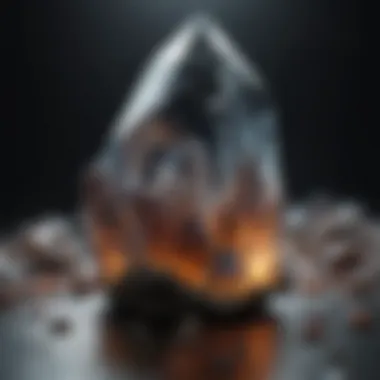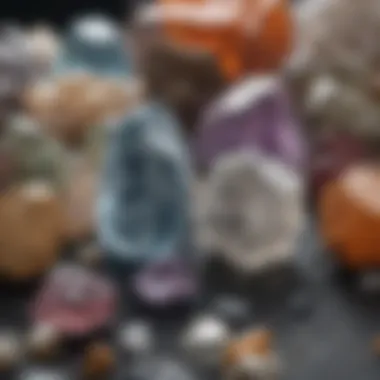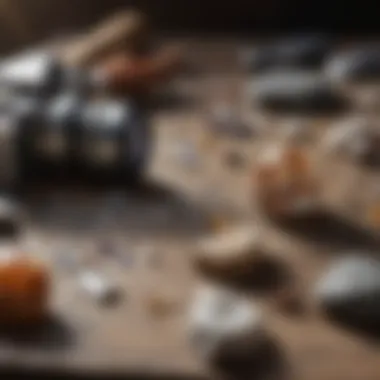Raw Crystal Identification Guide for Enthusiasts


Intro
The fascination with raw crystals is not merely a surface-level hobby; it dives deep into the intricate world of geology and aesthetics. Understanding how to identify these natural specimens can elevate one's connection to the earth and its processes. This guide aims to furnish collectors, hobbyists, and educators with the knowledge required to distinguish between various types of crystals effectively. We will embark on an exploration of their history, characteristics, and classification systems, creating a robust framework for appreciation and understanding.
History and Origins
Overview of Collectibles, Rocks, and Fossils
Collecting raw crystals has a storied history that interweaves human culture with nature's artistry. From ancient civilizations to modern-day enthusiasts, the allure of gemstones and minerals has captivated many. Early explorers often documented their finds, which contributed to the formation of various disciplines within geology and mineralogy.
As a hobby, collecting encourages individuals to engage with the outdoors, sparking interest in geology, biology, and even chemistry. Some collectors focus purely on aesthetics, while others are drawn to the scientific value these specimens might hold.
Historical Significance and Cultural Impact
Throughout history, crystals have held significant cultural value. In many cultures, they are believed to possess metaphysical properties. For instance, quartz crystals were used in ancient Egypt for protection against evil forces. Today, they are often used in alternative healing practices. The cultural impact extends beyond spiritual beliefs; notable specimens have influenced art, industry, and technology.
"Crystal collecting is not just a pastime; it's a connection to earth's history and humanity's quest for knowledge."
Identification and Classification
Guide to Identifying Rocks and Fossils
Identifying raw crystals requires an understanding of their physical properties. Key characteristics include color, clarity, luster, and crystal form. Here are some practical steps for identification:
- Visual Inspection: Examine the surface for color variations, transparency, and any unique patterns.
- Hardness Test: Use the Mohs hardness scale to evaluate how well a specimen resists scratching.
- Cleavage and Fracture: Notice how a crystal breaks. Certain minerals have specific cleavage patterns that can aid identification.
Common Types and Variations
Among the plethora of raw crystals, certain types are more prevalent in collections. Common examples include:
- Amethyst: Known for its purple hue, this quartz variant is popular among collectors.
- Rose Quartz: Its pink color makes it a favorite for both collectors and jewelers.
- Quartz: A versatile mineral, found in various forms and colors, it is one of the most common crystallized minerals.
Understanding these variations allows collectors to better appreciate their unique qualities and the geological processes that formed them.
Through this guide, we hope to enrich your experience with raw crystals, allowing for a deeper appreciation of these natural works of art. Each finding is not just a crystal; it symbolizes the intertwining of earth's history with human curiosity.
Understanding Raw Crystals
Understanding raw crystals forms the bedrock of any serious exploration into the world of minerals. Crystals are not just decorative items; they hold intrinsic value, both scientifically and aesthetically. The study of raw crystals encompasses their formation, physical characteristics, and classification systems. Returning to the fundamentals allows collectors to appreciate the uniqueness of each specimen, enriching their collection experience.
Familiarizing oneself with the foundational concepts related to raw crystals is crucial. Knowledge about their properties aids in identification and absorption of their features. This understanding can help avoid common pitfalls, such as misidentifying a crystal or overlooking its significance. In addition, this groundwork prepares enthusiasts to delve into more advanced topics, fostering a deeper appreciation of the geological processes that shape our planet.
Definition of Raw Crystals
Raw crystals refer to minerals that have not been polished or altered in any way. They are the natural formations that occur without human interference, showcasing their original state. Crystals develop through various geological processes. These can include cooling of magma, evaporation of liquids, or even metamorphism from existing rocks. In essence, raw crystals offer a snapshot of the Earth's history, encapsulating information about the conditions under which they formed.
Crystals exhibit specific structures due to their atomic arrangements. This structure can dictate characteristics like hardness, cleavage, and optical properties. These features are essential for any collector or enthusiast in identifying and categorizing crystals. Moreover, identifying raw crystals can lead to an understanding of their potential uses in various fields, including metaphysical practices and industrial applications.
Significance in Collecting
Collecting raw crystals allows enthusiasts to connect with nature on a profound level. Each piece collected tells a story—its origin, formation, and the environment in which it was found. For many, the hobby goes beyond simple aesthetics; it is about preserving natural history. Furthermore, raw crystals can exhibit remarkable beauty, ranging from vibrant colors to intricate formations, which reinforces their desirability among collectors.
Additionally, possessing a diverse collection can be intellectually stimulating. It encourages research and discussion among fellow enthusiasts and fosters a community of shared interests. While some collectors focus on aesthetic appeal, others might target specific types or geological formations, such as quartz or calcite. This diversity leads to a rich landscape of inquiry and learning.
"Understanding the properties and significance of raw crystals is not just an academic exercise; it’s a gateway to appreciating the vast complexities of our planet."
Ultimately, understanding raw crystals intertwines scientific inquiry and aesthetic appreciation. This synergy makes the subject both accessible and enriching.
By grasping the definitions and significance of raw crystals, collectors can enhance their passion for minerals. This clarity lays the groundwork for more advanced study in the later sections of this article.
Physical Properties of Crystals
Understanding the physical properties of crystals is crucial for anyone involved in crystal identification. These properties serve as the foundational criteria for distinguishing between different crystal types. Crystals exhibit unique physical characteristics that provide insight into their natural formation and classification. By scrutinizing these properties, collectors can make informed decisions and deepen their appreciation for their specimens.


Color and Transparency
The color of a crystal is often the first aspect people notice. It can vary widely among different specimens due to a number of factors including impurities and the crystal's internal structure. For instance, a clear quartz may house mineral inclusions that impart a distinct hue, while amethyst displays various shades of purple due to iron content. Color is neither a definitive nor reliable identifier, but it does reflect a crystal's quality and origin.
Transparency is equally important. A crystal can be transparent, translucent, or opaque. This varies based on the density of its atomic structure and how light interacts with it. For example, while quartz is typically transparent, other minerals such as hematite are opaque. Understanding how light behaves in and around a crystal helps collectors assess its clarity and quality.
Hardness and Density
Hardness refers to a crystal's resistance to scratching, measured on the Mohs scale. This scale ranges from talc, the softest mineral, to diamond, the hardest. By knowing a crystal's hardness, collectors can better understand its durability during handling and display. For example, while fluorspar ranks at 4 on the Mohs scale, garnet resides at 7. A crystal's hardness is significant not only for its physical durability but also for understanding its geological formation.
Density, or specific gravity, compares a crystal's mass to its volume. Dense minerals like lead ore show high specific gravity, while others, such as pumice, are much less dense. Knowing a crystal's density allows collectors and gemologists to identify minerals and their applications more accurately.
Luster and Clarity
Luster describes how a surface reflects light. Crystals can exhibit various types of luster, including metallic, vitreous, or dull. For instance, pyrite possesses a metallic luster, giving it a shiny appearance, while talc may appear dull or waxy. This property enhances the aesthetic appeal of the specimens and can aid in identification.
Clarity encompasses the presence of inclusions, blemishes, or other internal characteristics. Higher clarity often indicates greater value, particularly among gemstones. For instance, a flawless diamond is esteemed, while one with significant inclusions would be less valued. Evaluating clarity is essential for collectors, helping them understand the quality of their specimens and their potential market value.
By focusing on these physical properties, collectors enhance their identification skills and expand their understanding of the mineral kingdom.
Classification of Crystals
Classification of crystals is essential in understanding the rich diversity present within the mineral kingdom. By systematically categorizing crystals, collectors can not only identify specimens with greater accuracy but can also appreciate the complexities of their formation and properties. This classification helps in navigating the vast array of crystals available in the market and in nature, serving as a foundational aspect for any collector or enthusiast.
Systematic Classification
Systematic classification entails dividing crystals based on their inherent chemical properties and structural characteristics. Two key areas under this classification include Chemical Composition and Crystal Systems.
Chemical Composition
Chemical composition refers to the specific elements that make up a crystal. This aspect is crucial in identifying crystals, as different minerals possess distinct chemical identities. For instance, quartz is primarily composed of silicon dioxide (SiO2), while calcite consists of calcium carbonate (CaCO3). Understanding the chemical makeup allows collectors to recognize patterns and similarities among various specimens.
The primary characteristic of chemical composition is its role in indicating the properties and behaviors of crystals. This contributes significantly to the study of mineralogy, making it a popular choice among collectors and scholars alike. One unique feature of focusing on chemical composition is how minerals with similar structures can have vastly different properties due to variations in their elemental makeup.
However, reliance solely on chemical composition can present challenges. Natural variations, impurities, or weathering effects may alter a crystal's appearance, potentially leading to misidentification. Nonetheless, grasping chemical composition remains a foundational aspect of crystal classification and identification.
Crystal Systems
Crystal systems categorize crystals based on their geometric shape and symmetry. The classification is based on the arrangement of atoms within the crystal lattice. This classification is essential as it allows collectors to visually categorize crystals, often providing immediate recognition. There are seven primary crystal systems, such as cubic, tetragonal, and hexagonal, each with distinct visual traits.
Highlighting the unique characteristic of crystal systems, they serve as a useful framework for identifying crystals quickly. This systematization is beneficial for both novice and experienced collectors because it streamlines the identification process.
However, the complexity of crystal systems can sometimes be overwhelming. It requires a deeper understanding of crystallography for precise classification. Yet, these systems offer an invaluable perspective for understanding crystal structures and facilitating identification.
Mineral Groups
The next layer of crystal classification is based on mineral groups, which further divide crystals into related categories based on their chemical composition. Two widely recognized groups under this classification are Silicates and Carbonates.
Silicates
Silicates hold a critical place in the classification of crystals, as they form the largest class of minerals. Approximately 90% of the Earth's crust is made up of silicate minerals. Comprised mainly of silicon and oxygen, silicates exhibit a wide range of crystal forms and structures, making them versatile and appealing to collectors.
The key characteristic of silicates is their diverse structural configurations. These structural variations causes a rich variety of physical properties among silicates. The presence of different cations in the crystal structure can enhance or diminish certain traits, such as color and durability. This diversity in silicate minerals makes them a beneficial choice for collectors seeking unique specimens.
One advantage of focusing on silicates is their availability and accessibility. Many silicate minerals, such as feldspar and mica, are found abundantly and can be sourced easily. However, the vast variety may also lead to confusion, particularly for amateur collectors trying to differentiate similar-looking silicates.
Carbonates
Carbonates are another significant group of minerals that play a critical role in the classification of crystals. Comprised primarily of carbonate ions (CO3) bonded with metal ions, carbonates typically display distinct physical properties, such as effervescence in the presence of acid. Noted for their beautiful colors and patterns, they are especially appealing to collectors.
The key characteristic of carbonates is their solubility in acids, which distinguishes them from other mineral groups. This feature not only aids in identification but also strengthens their relevance in geological studies. As a result, carbonates are a popular choice among collectors due to their visual appeal and unique properties.
While the notable physical traits make carbonates attractive to collectors, there can also be disadvantages. The solubility in acid can lead to degradation over time if not properly cared for. Recognizing this aspect is crucial for collectors who aim to preserve these specimens long-term.


Understanding the classification of crystals is vital for anyone engaged in the world of mineral collecting. It provides a structured framework for identifying and appreciating the vast diversity of raw crystals. The detailed examination of systematic classification and mineral groups serves as a gateway into deeper exploration of each specimen's unique properties and history.
Using the Identification Chart
Understanding how to utilize the identification chart is essential for anyone interested in raw crystals. This chart serves as a practical guide, streamlining the identification process while enhancing one's understanding of different crystals. By referring to this chart consistently, collectors can quickly recognize and categorize their specimens with greater accuracy.
The main benefit of using an identification chart is its structured approach. It allows users to analyze various features of crystals systematically. Whether it’s color, luster, or hardness, each property provides clues to identify the mineral accurately. This focus on detail not only aids in identification but also deepens appreciation for the unique attributes of each specimen.
Additionally, understanding how to read the chart promotes confidence in mineral identification. Hobbyists can make informed decisions about their collection. Knowing the characteristics of a crystal can mean the difference between misidentification and recognizing a valuable specimen. Plus, it establishes a foundation for further exploration into advanced identification methods.
In summary, employing the identification chart is crucial for enthusiasts. It simplifies the identification process, fosters confidence, and enhances the experience of collecting raw crystals.
Structure of the Chart
The structure of the identification chart is designed for clarity and ease of use. Typically, the chart is organized in a grid format where each row corresponds to a different crystal species, and the columns represent various properties.
Some fundamental properties included in the chart are:
- Color: The primary hue of the crystal.
- Hardness: Measured using the Mohs scale.
- Luster: The quality of light reflection from the surface.
- Transparency: How transparent or opaque the crystal is.
- Crystal System: The geometric shape of the crystal.
Each column features brief descriptions or criteria that define each property. This logical arrangement enhances usability because users can quickly cross-reference a crystal’s characteristics against known data. The organization into distinct categories reduces the chance of confusion, making it more accessible for both beginners and seasoned collectors.
How to Interpret Features
Interpreting the features in the identification chart is an important step in recognizing raw crystals accurately. When examining a crystal, several factors can guide users in understanding its classification.
Start by looking at color. While it may seem straightforward, crystal color can vary widely due to impurities and other factors. Therefore, it’s important to compare the observed color with descriptions in the chart.
The next feature is hardness. Using the Mohs scale, collectors can physical tests to determine where on the scale a crystal lies. For instance, quartz with a hardness of 7 can scratch calcite, which has a hardness of 3.
Another feature is luster. Is it glassy, dull, or metallic? Recognizing the luster can provide clues to the mineral types, as specific lusters are characteristic of certain classes of minerals
Lastly, note the crystal system. Understanding the shapes and structures of crystals is fundamental to identification. The system categorizes the crystal into families based on its symmetry and lattice structure. Each crystal may have distinct features based on these systems, aiding collectors in making accurate identifications.
Overall, carefully interpreting these features using the chart will greatly facilitate a more insightful experience in identifying and appreciating raw crystals. By paying close attention to these details, collectors demonstrate their knowledge and respect for the natural world.
Common Raw Crystals
The inclusion of common raw crystals in this guide serves multiple purposes. First, it establishes a foundation for beginners and experts alike. Each specimen has unique properties that are essential for any rock and mineral collector to understand. Familiarity with these crystals can be beneficial for identification purposes and broaden an enthusiast’s appreciation of what they might find in the field.
Moreover, many common raw crystals are sought after not only for their aesthetic value but also for their purported metaphysical properties. This duality - being both beautiful and significant in various cultures - makes them worthy of detailed examination. Collectors gain the advantage of recognizing their potential value, whether monetary or spiritual, based on their knowledge of these common varieties.
Quartz
Quartz is one of the most prevalent minerals found on Earth. This crystal can be clear or come in myriad colors, which makes it a versatile specimen. Its durability and abundance contribute to its importance in jewelry, industry, and spirituality. The clarity of quartz can range from transparent to opaque, which plays a role in its various applications.
In addition to its beauty, quartz has several types, including rose quartz and smoky quartz. Each type carries unique characteristics and cultural significance. For collectors, understanding the subtle differences can enhance sorting and identification during collection. Acknowledging its pervasiveness also allows collectors to appreciate the wide variety possible.
Amethyst
Amethyst, a violet variety of quartz, is highly prized for its stunning color and historical significance. Often used in jewelry and decor, it holds a special place in both geology and traditions. This crystal is thought to have calming properties and has been utilized in different cultures for centuries, such as in ancient Egypt and Greece.
When collectors identify amethyst, they should note its deep purple hue, which can vary significantly in shade. The presence of iron impurities can affect this coloration, resulting in a spectrum from light lavender to dark purple. Thus, recognizing amethyst not only offers aesthetic pleasure but also encourages appreciation for its chemical makeup and geological history.
Citrine
Citrine is another popular crystal, known for its warm yellow to orange tones. This variety of quartz is relatively rare in its natural state. As a result, many pieces on the market are actually heat-treated amethyst. Understanding these nuances is crucial for collectors to avoid misidentification.
The color of citrine ranges from pale yellow to a more intense amber. Collectors should also take into account the crystal structure, which often has a hexagonal form. Its significance in crystal healing practices is also a vital aspect of its appeal. Many believe citrine can attract prosperity and abundance, underlining the reasons it finds its way into many homes and collections.
Calcite
Calcite appears in a host of forms, colors, and crystal structures. Its translucent nature makes it an interesting specimen for collectors. Commonly found in shades of white, yellow, or orange, calcite can also exhibit fluorescence under UV light. Therefore, it’s essential for collectors to be aware of these unique properties during identification.


Calcite is an important mineral pertaining to geological studies as well, as it often forms in sedimentary environments. When collectors engage with calcite, they should consider its origin and possible applications in various fields. Recognizing calcite and its varieties may not only enrich a collection but also enhance understanding in surveys or studies within geology.
Advanced Identification Techniques
Understanding advanced identification techniques is vital for crystal enthusiasts seeking to deepen their knowledge of raw crystals. These methods provide a more scientific approach to identification beyond basic visual inspection. Collectors benefit significantly from these techniques as they not only confirm the type of crystal but also provide insight into its properties, location of origin, and potential value.
Field Tests
Field tests serve as initial and accessible identification methods that can be performed on-site during the collection of raw crystals. These practices encourage collectors to engage directly with their specimens in natural settings. Field tests typically focus on characteristics such as hardness, streak, and reactivity to common substances like acid.
- Hardness Test: This test often uses the Mohs hardness scale. Collectors can scratch their crystal against known materials like a fingernail, copper coin, or glass to evaluate the hardness.
- Streak Test: Rubbing the crystal on a porcelain plate creates a streak, revealing the mineral’s true color in powdered form.
- Acid Test: Some carbonates react visibly with hydrochloric acid, which is helpful for identification. A quick drop of acid will produce bubbles if the crystal is calcite, for instance.
These tests might seem straightforward, but they require careful execution and observation. Engaging with these techniques helps enhance a collector's understanding of the material and reinforces the importance of hands-on experience.
Laboratory Analysis
For more precise identification, laboratory analysis offers sophisticated techniques that yield detailed information about raw crystals. While these methods might not be feasible for casual collectors due to cost and accessibility, understanding them can be beneficial for serious enthusiasts. They include:
- X-Ray Diffraction (XRD): This method provides crystal structure information, allowing for accurate mineral identification at the atomic level.
- Scanning Electron Microscopy (SEM): SEM offers high-resolution images of crystal surfaces. It helps identify fine details that are crucial for understanding the specimen’s properties.
- Chemical Analysis: Techniques like energy-dispersive X-ray spectroscopy (EDX) provide information on elemental composition. This can confirm the presence of specific minerals that might be hard to distinguish visually.
Despite the complexity and cost, laboratory techniques yield invaluable data for collectors seeking to validate their findings. They can solidify identification and add credibility to a collector's claims when sharing specimens with others.
Advanced identification techniques are essential for deepening understanding and enhancing the value of raw crystal collections.
Practical Tips for Collectors
Collecting raw crystals is not only a rewarding hobby but also a journey into the natural world of geology and aesthetics. The importance of practical tips in this context cannot be understated. These tips bridge the gap between simply acquiring crystals and truly appreciating their intrinsic value. Knowledge about care, handling, and storage enhances the ownership experience, making the pursuit of collecting both enjoyable and educational.
Caring for Raw Crystals
Proper care for raw crystals is essential to maintain their condition and beauty. The durability of each specimen varies significantly, influenced by its composition. Certain minerals, like quartz, are robust, while others, such as calcite, are more fragile. Here are key care practices:
- Gentle Cleaning: Use a soft cloth to wipe dust and dirt. For deeper cleaning, lukewarm water and a mild detergent are advisable.
- Avoid Harsh Chemicals: Stay away from bleach or abrasive cleaners which can damage the surface.
- Limit Sun Exposure: Prolonged sunlight may fade colors in some crystals, eventually diminishing their visual appeal.
Taking time to care for your collection extends its life. This attentiveness allows you to enjoy your specimens both aesthetically and emotionally, crafting a deep connection to the minerals you gather.
Storage Considerations
Storage plays a vital role in protecting raw crystals from damage. The environment in which they are stored can significantly affect their optical and physical characteristics. Consider the following strategies for effective storage:
- Temperature and Humidity Control: Store crystals in a cool, dry place to prevent any chemical reactions that might occur in damp conditions.
- Use Soft Linings: Place crystals in padded boxes or containers lined with soft fabric to prevent scratches or chips.
- Categorize by Type: Organize your collection by mineral type or color to enhance both accessibility and aesthetic value.
Adhering to these storage principles not only safeguards your collection but also enhances its presentation. A well-maintained collection can serve as an educational tool, inviting deeper exploration into the world of geology.
"The way crystals are treated and stored often reflects the respect that collectors have for these natural artifacts."
In summary, practical tips for collectors emphasize a disciplined approach to managing raw crystals. By focusing on care and thoughtful storage, collectors can elevate their experience while preserving the integrity of their stunning specimens.
Resources and References
Understanding the identification and appreciation of raw crystals entails not just hands-on experience, but also the availability of reliable resources and references. These components are essential for anyone looking to deepen their knowledge in this fascinating field. In this section, we will explore the significance of resources, focusing on both literature and community interactions that enhance the learning process.
Books on Crystal Identification
Books provide an invaluable foundation for anyone interested in crystal identification. They often contain detailed information about the various types of crystals, their characteristics, and the methods applied in their identification. The depth and breadth of the material within these books can enhance a collector's knowledge base and serve as a reference point for ongoing study.
Specific titles that are recognized in the realm of crystal identification include just a few of the following:
- "The Crystal Bible" by Judy Hall offers comprehensive details about individual crystals, including their formations and uses.
- "Crystals: A Guide to Using the Crystal Energy" by Philip Permutt focuses on the metaphysical properties along with identification strategies.
On top of simply providing descriptions, many of these books emphasize the application of knowledge in practical settings, enriching the collector's experience. This enables readers to internalize information through active engagement rather than rote memorization.
Online Communities and Forums
The emergence of digital platforms has transformed how rock and fossil collectors connect and share their knowledge. Online communities and forums provide a space for enthusiasts to exchange ideas, seek advice, and share identification challenges. Platforms like Reddit and Facebook host specialized groups where members can post images of their crystals, request identifications, and receive feedback from experienced collectors.
Participating in these communities can lead to:
- Access to a diverse range of experiences and perspectives on crystal identification.
- Real-time responses to queries that can enhance learning.
- The opportunity to network with like-minded individuals, fostering a sense of belonging.
Overall, the integration of both books and online forums creates a more robust learning environment for crystal collectors. Each resource serves as a building block that enhances understanding, encouraging lifelong learning and appreciation of raw crystals.



